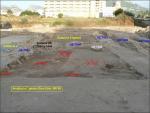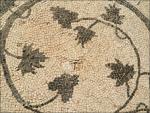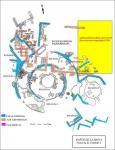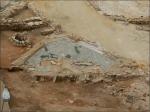Summary (English)
Since the 18th century, this site has generated a substantial bibliography. On this occasion, the excavation area has focused on the northern part of the Domus I, already known for its singular circular mosaic. The archaeological works revealed its continuity with a room of the Paleochristian church identified during the 2006 season. The main aim of this archaeological season was to delineate the perimeter of the religious building from the east, where the bulk of the work focused. 140 square meters were excavated in total.
The works to be carried out were:
1) Enlargement of the excavation area to the east, which showed a high degree of alteration linked to destructive processes of the 1970s which affected that part of the site. Interpretation of the documented structures was difficult because the site underwent considerable modifications. By examining the superimposition of the walls from different periods we have proven the existence of a religious building dating from the Paleochristian period (6th-7th Centuries AD) built over a large Roman house from the late 3rd or 4th century.
The excavated materials confirm a chronological range from High-Imperial glass, through to Roman ceramics characteristic of the 4th century, to Medieval pottery and structural remains.2) Redefinition of some units excavated during the 2005 season, located to the north and forming part of a dump dating from 4th and 5th centuries. The discovery of material from the 6th century AD and some medieval ceramic remains, as well as a large quantity of marbles and tegula indicate a certain degree of contamination at the time of destruction of the Domus I.
3) Cleaning of the stratigraphic units in the western part of the site. We worked on the preparation of the soils and room remains for the immediate recovery of the opus sectile by the technical restoration team.
4) Recovery of the ancient burials. Interiors of the tombs excavated in previous seasons were emptied of sediments and the structures were cleaned. The interiors were filled with a geotextile layer and medium gravel of a white colour to facilitate the view of interments within the archaeological complex.
5) Cleaning and preparation of the site. The walkways used by the restoration team were removed and the structures affected by vegetation were grubbed. In rare instances it was the ancient structures were redefined in order to ascertain the interrelation and the cultural sequence of the site.
In brief, our key objective was to delimit the Paleochristian religious building which was founded following the abandonment of the large Domus I in the late 3rd or early 4th centuries. This process had been initiated during the 2006 season with the discovery of its baptistery; the severe alteration of the strata and the structures in the eastern part were then verified.
Another key factor during the 2008 campaign was the establishment of a Flora Micro-reserve dedicated to the Allium subvillosum in the archaeological area of Baños de la Reina. Thus, the interesting natural heritage of the site is added to its well-known archaeological relevance.
(translation by Esther Casares Carmona)
- Anna Mª Ronda Femenia y Alicia Luján Navas
Director
- Anna María Ronda Femenia y Alicia Luján Navas
Team
- Museo Arqueológico de Calpe
- Campo de Trabajo del Instituto Valenciano de la Juventud (IVAJ)
Research Body
- Colegio Oficial de Doctores y Licenciados en Filosofía y Letras y en Ciencias de Alicante - Sección de Arqueología
Funding Body
- Ayuntamiento de Calpe – Instituto Valenciano de la Juventud (IVAJ)






![Download [PDF]](/excavation/skins/fasti/images/results/download_sml.png)


